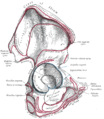
Ilium (bone)
The ilium (/ˈɪliəm/) (pl.: ilia) is the uppermost and largest region of the coxal bone, and appears in most vertebrates including mammals and birds, but not bony fish. All reptiles have an ilium except snakes, although some snake species have a tiny bone which is considered to be an ilium.[1]
For other uses, see Ilium.Ilium of pelvis
The ilium of the human is divisible into two parts, the body and the wing; the separation is indicated on the top surface by a curved line, the arcuate line, and on the external surface by the margin of the acetabulum.
The name comes from the Latin (ile, ilis), meaning "groin" or "flank".[2]
Other animals[edit]
Dinosaurs[edit]
The clade Dinosauria is divided into the Saurischia and Ornithischia based on hip structure, including importantly that of the ilium.[5] In both saurischians and ornithischians, the ilium extends laterally to both sides from the axis of the body. The other two hip bones, the ischium and the pubis, extend ventrally down from the ilium towards the belly of the animal. The acetabulum, which can be thought of as a "hip-socket", is an opening on each side of the pelvic girdle formed where the ischium, ilium, and pubis all meet, and into which the head of the femur inserts. The orientation and position of the acetabulum is one of the main morphological traits that caused dinosaurs to walk in an upright posture with their legs directly underneath their bodies. The brevis fossa is a deep groove in the underside of the postacetabular process, the rear part of the ilium. The brevis shelf is the bony ridge at the inner side of the fossa, the bone wall forming the internal face of the rear part of the ilium, which functions as an attachment area for a tail muscle, the musculus caudofemoralis brevis.[6] Often, close to the hip-socket the lower edge of the outer face of the postacetabular process is positioned higher than the edge of the brevis shelf, exposing the latter in side view.
History[edit]
The 'English' name ilium as bone of the pelvis can be traced back to the writings of anatomists Andreas Vesalius, who coined the expression os ilium.[7] In this expression ilium can be considered as the genitive plural of the nominative singular of the noun ile.[7] Ile in classical Latin can refer to the flank of the body,[8] or to the groin,[8] or the part of the abdomen from the lowest ribs to the pubes.[8] Ile is usually encountered as plural (ilia) in classical Latin.[8] The os ilium can literally be translated as bone (Latin: os[8] ) of the flanks.
More than a millennium earlier the ossa ilium were described by the Greek physician Galen, and referred to as, with a quite similar expression, τά πλατέα λαγόνων ὀστᾶ, the flat bones of the flanks,[7] with λαγών for flank.[9] In anatomic Latin, the expression os lagonicum[10] can also be found, based on Ancient Greek λαγών. In modern Greek the nominalized adjective λαγόνιο[11] is used to refer to the os ilium.
In Latin and Greek it is not uncommon to nominalize adjectives, e.g. stimulantia from remedia stimulantia[12] or ὁ ἐγκέφαλος from ὁ ἐγκέφαλος μυελός.[13] The name ilium as used in English[14][15] can not be considered as nominalized adjective derived from the full Latin expression os ilium, as ilium in this expression is a genitive plural of a noun[7] and not a nominative singular of an adjective. The form ilium in English is however thought to be derived from the Latin word ilium,[16] an orthographic variant in Latin of ile,[8][16] flank or groin.[8] Whereas the expression of Andreas Vesalius os ilium appropriately expresses bone of the flanks, the sole term ilium as used in English, lacks this precision and has to be literally translated as groin or flank.
There exists however in classical Latin an adjective ilius/ilia/ilium. This adjective however means not with respect to the flanks, but Trojan.[8] Troy is referred to in classical Latin as Ilium,[8] Ilion[8] or Ilios[17] and in ancient Greek as Ἴλιον[9] or Ἴλιος.[9]
The first editions of the official Latin nomenclature, Nomina Anatomica of the first 80 years (first in 1895) used the Vesalian expression os ilium.[18][19][20][21][22][23] In the subsequent editions from 1983[24] and 1989[25] the expression os ilium was altered to os ilii. This latter expression supposes a genitive singular of the alternate noun ilium instead of a genitive plural of the noun ile. Quite inconsistently, in the 1983 edition[24] of the Nomina Anatomica the genitive plural of ile (instead of ilium) is still being used in such expressions as vena circumflexa ilium superficialis. In the current 1998 edition of the Nomina Anatomica, rebaptized as Terminologia Anatomica, the expression os ilium is reintroduced and os ilii deleted.





